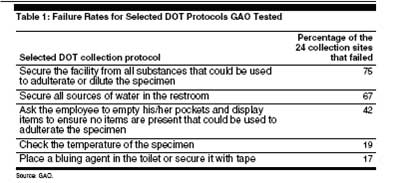Motor carriers are required to test their drivers for drugs, and most do so using third party testing labs that in theory meet DOT requirements. These requirements include the need for a photo ID, lack of access by drivers to clear water and other substances, requiring drivers to first empty their pockets before the test, and other measures.
As shown in the chart below, a high percentage of the 24 testing sites visited failed to adequately follow testing requirements.

In addition, the GAO found chemicals capable of thwarting the drug tests were widely available over the internet, and that the testing labs were not capable of detecting those substances.
What’s the Likely Impact?
Currently, commercial motor carriers are required to do drug testing pre-employment, if there are any reasonable suspicions regarding a driver, randomly, and post-accident. In general, private fleets are exempt, though many companies have their own driver testing programs.
While statistics show truck related fatalities are decreasing of late, and that driver error, not drugs, is responsible for the vast majority of accidents, a few high profile fatalities have led many to be concerned about this issue. This includes Jim Oberstar, D-Minn., chairman of the House Transportation and Infrastructure Committee.
Oberstar said he found the GAO report “frankly astonishing and shocking and dismaying. You can manipulate the tests, you can mask substance abuse and go undetected on the roadways.”
The report likely will lead to tougher regulations on the testing facilities and more scrutiny in terms of achieving and maintaining certifications. The GAO itself is going to make a series of recommendations, which it hopes to complete by May, 2008.
The issue can get complicated. While everyone wants to get “high” drivers off the road, tougher testing could in fact exacerbate the current over the road driver shortage.
The plans to allow Mexican drivers into the US, as part of the NAFTA agreement, will also raise questions. Will Mexican standards and enforcement mirror those of the US, especially potentially tougher versions?
And as always, liability today will be an increasing issue. If a carrier – and potentially even a shipper using a carrier – be vulnerable to greater damages for an accident if it turns out they were using a testing facility that did not do the required job of driver testing?
What’s your reaction to the GAO report – is it a real issue, or nothing to really be concerned about? What is the best approach to controlling driver drug usage? And how should drivers from Mexico and Canada be handled? Let us know your thoughts at the Feedback button below.
|